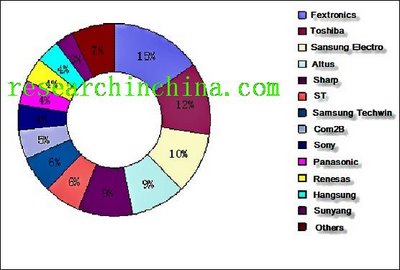"The global mobile phone shipment in 2005 was 795 million units, 57% of which (about 455 million units) had the photographing function. It is predicted that 85% of the mobile phones will be camera phones by 2008 with a shipment of 800 million units; and the market scale of camera phone module will accordingly rise from $2 billion in 2005 to $4.8 billion by 2008, showing very promising prospects.
Table: Relationship between CMOS sensor IC and wafer plants
| Manufacturer | Maximum pixel (megapixel) | Manufacturing plant |
| OmniVision | 5.17 | TSMC |
| Micron | 5.04 | Has its own wafer plant |
| Magnachip | 3.2 | Has its own wafer plant |
| ST | 2 | Has its own wafer plant |
| ESST | 1.3 | Has its own wafer plant |
| Transchip | 2 | TSMC |
| Agilent | 5 | TSMC |
| pixelplus | 3.2 | Dongbu Anam |
| Kodak | 30 | IBM |
| Toshiba | 3.2 | Has its own wafer plant |
| Crypress | 3 | Has its own wafer plant |
| Samsung | 7 | Has its own wafer plant |
| Pixart | 1.3 | Subsidiary of UMC |
| TASC | 2.1 | TSMC |
| ElecVision | 0.3 | TSMC |
| Galaxycore | 3 | SMIC |
Lens manufacturers are concentrated in Taiwan, Japan and South Korea. Due to its high technology content, Lens industry has a high entry threshold. And Taiwan-based enterprises are obviously advantageous in costs with a market share of 57% in 2005, which is expected to reach 65% by 2006.
There are 4 major camera phone lens manufacturers in Taiwan are Genius, Largan, Asia Optical, and Premier. The global market shares for those four are 23%, 25%, 5% and 4% respectively
With the pixel upgrade of camera phones, more and more lens manufacturers are engaged in glass lens manufacturing, but the manufacturers who only have plastic lens technologies are declining. Enplas, for instance, whose sales revenue reduced 6 billion yen with a profit decline from 8.45 billion yen to 3.7 billion yen. Especially in 2-megapixel camera phone lens market, glass lens manufacturers are taking obvious advantages; the optical giants like Fujinon, Konica Minolta, and Largan almost monopolize the market.
Market shares of major 1.3-megapixel lens manufacturers, 2005Q2:

As for assembly industry, Flextronics has become the largest camera phone module manufacturer in the world after it acquired the CMOS image sensor department of Agilent, and the image sensor testing plant of ASE; however, it does not have very efficient R&D. Altus, affiliated to Foxconn Group, developed fast, and its market share has risen from 4% in 2004 to 9% in the second half of 2005 with a shipment of 41 million sets. Meanwhile,
Market shares of major camera module assembly manufacturers, second half of 2005:

No comments:
Post a Comment
All comments are moderated to avoid spam and personal attacks.